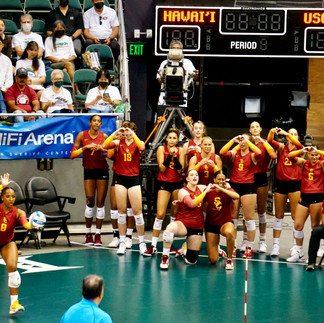Sports over the Rainbow – The Stadiums of Hawaii
- Ken Smoller
- Dec 11, 2023
- 20 min read
Updated: Mar 8, 2024

All photos and text by Ken Smoller (@stadiumvagabond). ©2023 – All rights reserved.
When travelers think about a Hawaiian holiday, they dream of a tropical paradise filled with sun, surf and shaved ice(1). Rarely does a football gridiron or an arena packed with volleyball fans come to mind. As a sun-averse vacationer who lacks a chill beach vibe, I wanted to experience Hawaii with a twist on a recent 5,092 mile trek from Boston. Specifically, I wanted find all of the stadiums and sporting events on the Islands of Aloha.

View from a helicopter of Diamond Head Crater and Honolulu, Hawaii’s capital and largest city on the island of Oahu.
Top Left: Travelers are greeted with the “Aloha Spirit” throughout the islands of Hawaii. Top Right: Honolulu and Diamond Head Crater viewed from the top of Punchbowl Crater. Bottom Left: The University of Hawaii Rainbow Warrior football team took the field accompanied by traditional Polynesian performers. Bottom Right: Shaved Ice is a special Hawaiian treat that vaguely resembles a snow cone, but with more complex flavors and textures.
Throughout my decades of travel, I had been to all 48 contiguous United States. Somehow, as “The Simpsons” once amusingly described them, I had missed the “freak states”. Perhaps the 11-plus hour non-stop flight scared me off. Perhaps it was memories of the Brady Bunch’s tiki troubles in the early 70’s. Whatever the reason, my family decided to make a Hawaii trip happen after my 10 year old son worked his tail off on a power point presentation pleading for this to be our next big family vacation destination. After two pandemic-related delays, we finally embarked on the long plane ride to the Aloha State.
Top: My son’s power point presentation convinced the family to make the long journey from Boston to Hawaii. Bottom: After the 11½ hour flight, the mountains of Oahu greeted our Hawaiian Airlines plane.
Traditionally, people associate Hawaii with water sports rather than ball games. Hawaii’s most famous and beloved athlete is the late Duke Kahanamoku(2) (1890-1968). Not only was Duke a five-time Olympic medalist in swimming, but he helped popularize surfing and water sports. There are prominent reminders of Duke in Hawaii’s largest city of Honolulu. First, a larger than life-size statue of Duke proudly stands in the heart of Waikiki Beach, adorned with fresh leis from his devotees. The so-called “human fish’s” spirit is honored each August on Waikiki Beach at the “Duke Kahanamoku Ocean Festival”. The two-week water sports extravaganza features surfing, body-surfing, swimming, diving, sailing and outrigger canoe paddling.
Top Left: A statute of Duke Kahanamoku stands proudly at the heart of Waikiki Beach. Top Middle: Each August, Duke’s legacy is honored with a two week water sports festival. Top Right: Waikiki Beach as seen from a helicopter. Bottom: Canoe racing on Waikiki Beach during the 2023 Duke Kahanamoku Ocean Festival.
Besides Duke’s statue and the festival, swimming fans can gaze upon the ruins of a stadium where the “Bronze Duke” once swam laps. Built in 1927 as a “tribute to the men and women who served during the “Great War"(3), the Waikiki Natatorium War Memorial was a public ocean water pool. The 100 X 40 meter saltwater swimming facility has been closed since the 1980s and has become a major cause of preservationists such as the National Trust for Historic Preservation.
The Waikiki Natatorium War Memorial was a public ocean water pool until it closed in the 1980s.
Hawaii is better known, however, for its war memorial in Pearl Harbor. Not only is the U.S.S. Arizona Memorial in Pearl Harbor a memorial to those who lost their lives in the surprise attack on December 7, 1941, but it also serves as the final resting place of 1,177 sailors and Marines who died on the U.S.S. Arizona during the attack. The site also is the watery tomb for 44 surviving veterans(4) who later passed and were interred there. In order to access the moving and thought provoking memorial, it is important to secure $1 advanced tickets online. The roundtrip ferry boat takes about 45 minutes total, but there are a number of other related military sites around Pearl Harbor that can provide a whole day’s worth of exploration and reflection. Regardless of the length of one’s visit to the area, spending time in and around Pearl Harbor provides a sobering reminder of the human cost of war.
Top Left: The U.S.S. Arizona Memorial floats just above the doomed seacraft and the watery grave for the victims of the attack. Top Right: Pearl Harbor from above, with various monuments to the infamous attack from December 7, 1941. Bottom Left: The memorial is relatively simple and allows for quiet reflection. Bottom Right: The Pearl Harbor sites also include the Pacific Fleet Submarine Museum, the Battleship Missouri Memorial and the Pearl Harbor Aviation Museum.
Near Pearl Harbor is a historic football venue that will soon meet its demise. Aloha Stadium opened on Sept. 13, 1975 as the home of the University of Hawaii Rainbow Warriors football team and the Hawaii High School football championship. Most American sports know the 50,000 seat stadium as the longtime home of the NFL Pro Bowl and the annual Aloha Bowl. Although it has diminished in importance today, the Pro Bowl in Hawaii’s biggest stadium used to draw over 13 million television viewers in early years of the 21st Century.

One of the most unusual features of Aloha Stadium was its convertibility for baseball. Four of the six 14-story tall grandstand sections could move on air casters to configure the stadium for minor league baseball games when the Hawaii Islanders of the Pacific Coast League called Oahu its home(5). During a three-game stint in 1997, the stadium became a major league ballpark when it hosted the San Diego Padres and St. Louis Cardinals. The 3.5 million pound, 7,000 seat grandstands were movable with air cushion technology borrowed from NASA’s Apollo program. The photo on the left below shows the current locked football configuration in comparison to the baseball configuration in this public domain photo from Wikipedia. The stadium also could be configured in a diamond shape for concerts. Due to maintenance and financial considerations, the stadium has remained locked in the football configuration since 2007(6). The track upon which the grandstands moved is visible in the photo below.
Although locked since 2007, Aloha Stadium used to have moving grandstands that floated along a track on air cushions.
Before being locked in placed, Aloha Stadium’s stands could be moved to accommodate both football and baseball.
Due to a variety of maintenance issues and rust, Aloha Stadium has been condemned. The derisively nicknamed “Rust Palace” originally was designed with a protective patina that actually accelerated the rust problem. It has been closed to fans since the start of the Covid pandemic and is slated for demolition and redevelopment. Today, the huge parking lots surrounding the stadium is used mainly for the huge Aloha Stadium Swap Meet and Marketplace, attracting over a million shoppers annually. Three times a week on Wednesday, Saturday and Sunday, over 400 vendors, crafters, artists and purveyors with all sorts of local delicacies, set up shop in the parking lots. In the meantime, discussions continue on the intended $350 million project that will be a public/private partnership.
Top Left: The Aloha Stadium Swap Meet offers all sorts of goods, including great options for lei’s of all varieties.
Top Right and Bottom: Hawaii’s diverse culinary treats will satisfy any appetite at the Aloha Stadium Swap Meet.
While much of the island of Oahu is the tropical paradise of holiday dreams, its largest city Honolulu is the state capital, an important commercial center and a historical royal seat. Before Hawaii became a territory of the United States in 1898 and a state in 1959, the territory had been an independent sovereign kingdom from 1810 until 1893 when the monarchy was overthrown by American and European business interests. The last sovereign ruler was H.M. Queen Liliʻuokalani, who remained the Queen “under occupation” until 1917 when she died without an heir. Her royal residence, ‘Iolani Palace, was built in 1879 and still stands next to the distinctive Hawaii State Capitol, built in 1969. The adjacent area includes a number of historic buildings from the missionary era. Perhaps the most remarkable building in the capital district is the Aliʻiolani Hale, which is now the state Supreme Court, but was once intended to be a palace.

Downtown Honolulu and the Capitol Building as viewed from the top of Punch Bowl Crater.
Top: Hawaii’s Capitol Building was built in 1969. Bottom Left: ‘Iolani Palace is the only royal palace on United States soil and was once home to H.M. Queen Lili’uokalani. Bottom Middle: Queen Lili’uokalani is honored with a statue next to the state capitol building, which is covered in flowers on her 185th birthday on September 2, 2023. Bottom Right: Ali’iolani Hale, now home to the Hawaii Supreme Court.
Honolulu is a diverse melting pot, which is clearly evident in its dining options in and
around downtown. Chinatown offers a wide range of dining options such as dim sum at
at The Pig and the Lady. Besides wonderful food, Chinatown had a number of old
architectural gems and shopping opportunities beyond the ubiquitous ABC Stores(7).

The Nu’uanu Stream runs through Chinatown on the northern side of downtown Honolulu.
Top Left: Senia and The Pig and the Lady are two popular foodie dining destinations in Chinatown that require reservations, sometimes substantially in advance. Top Middle: Inventive cuisine at Senia in downtown Honolulu. Top Right: Dim sum menu at Mei Sum. Bottom Left: The Maunakea Marketplace in Chinatown. Bottom Right: Typical souvenirs found at an ABC store in the touristy areas of Hawaii.
Beyond its cuisine, the varied architecture reflects the diverse backgrounds of the
people who have migrated to Hawaii since the Tahitians first arrived on the Big Island
about a millennium ago. There are both Eastern and Western influences on display,
especially in Honolulu.
Top Left: The historic Hawaii Theater on the edge of Chinatown was built in 1922 for vaudeville shows and silent films. Top Middle: The idiosyncratic façade of the Waikiki Galleria Tower in the heart of the Honolulu shopping district. Top Right: The ten-story Aloha Tower is a former lighthouse that has greeted arriving ships and cruises since 1926. Bottom Left: The Wo Fat restaurant building opened in 1938 and slated to be redeveloped into a boutique hotel. Bottom Right: The towers of the Ala Moana district.
While Honolulu governmental officials continue their planning for the demolition and redevelopment of the Aloha Stadium site, the University of Hawaii football team still need a place to play. The current plan of the New Aloha Stadium & Entertainment District (NASED) is to complete a new stadium in time for the 2028 football season. For now, UH has opted to move back to its Manoa campus a few miles from Waikiki Beach. Starting in 2022, the team has played at Clarence T. C. Ching Athletics Complex in the middle of the university’s athletic facilities. Previously, the site had been the practice field for the football team and the stadium for the UH women’s soccer team.

The Ching Athletic Complex sits in the heart of the UH’s lower campus amongst the school’s other athletic facilities.
Top: While plans materialize for a replacement for Aloha Stadium, the Rainbow Warriors will play in the makeshift complex on campus, featuring a phalanx of porta potties and visiting locker rooms in the concourse of the adjacent baseball stadium. Middle Left: Diamond Head Crater rises over the end zone of the Ching Athletic Complex. Middle Right: Duke Kahanamoku Aquatic Complex. Bottom Left: Rainbow Wahine Softball Stadium. Bottom Right: Clarence T.C. Ching Athletics Complex Beach Volleyball venue seats 778 fans.
During years when the Rainbow Warriors(8) were playing winning football, Aloha Stadium rocked with fans, with a record high of 49,651 in attendance on November 23, 2007 against Boise State. The football team now plays in a more modest home. Ching Athletic Stadium’s original capacity was 4,100, before the University expanded the stadium to 9,300 in 2022 and 15,194 in 2023. Even at the new capacity, the pasted together stadium remains one the smallest FBS facilities. Despite the team having over a century of history since their forming in 1909, it must accept incremental stadium changes for the near future. As part of the 2023 expansion, the Aloha Stadium video replay scoreboard has been moved to the Ching Complex.
Although not as impressive as Aloha Stadium, playing on campus provides students with the ability to walk to games. As a result, the small makeshift stadium provides a great atmosphere with student section being packed well before kickoff. The University has further plans to expand the stadium in 2024, which will enhance the team’s ability to comply with FBS attendance requirements. In addition to Rainbow Warrior football, the stadium is the current host of the annual Hawaii Bowl, including the 2023 matchup between Coastal Carolina and San José State.

The Rainbow Warriors attracted a crowd of 12,547 for a nationally televised opening night game against Stanford on September 1, 2023.
Top Left: UH students come early to pack the “Bowzone”, with the so-called “Bowzos” generating a vibrant and energetic game atmoshphere. Top Right: Ching Athletic Complex as fans filled up the stands for opening game 2023. Bottom: Fans catch pregame action for a parking structure overlooking the Ching Athletic Complex.
Those fans who arrive early for Rainbow Warrior football games are treated to a variety of pregame activities. Fans can cool off in the shade, listen to live bands and a DJ, bounce in the Kieki Zone, grab a brew in the beer garden or play various games in UH’s adjacent Les Murakami Stadium. The “Kickoff at the Less” opens two hours before kickoff. The impressive college ballpark has an amazing view of Diamond Head Crater and the Manoa neighborhood. When not used as a pregame playground, the 4,312 seat ballpark has housed UH’s baseball team since 1984.

The 4,312 Les Murakami Stadium is both a pregame playground for Rainbow Warrior football games and home to the UH baseball team.
Left: The pregame Kieki zone has variety of inflatable attractions for fans arriving early for football games on campus. Middle: The “Les” is one of the more impressive ballparks in college baseball. Right: The ballpark’s student section for “Manoa Maniacs.”
During its second season on campus, the University spiced up dining options for fans.
In addition to the customary foods one expects at football games, there are now a
variety of food stands that offer a wide variety of traditional Hawaiian and international
flavors such as potstickers, yakitori, curry chicken, boba tea, kalua pig, turkey tail
adobo, poke and, of course, shave ice.
Food options at the Ching Athletic Complex includes both standard stadium fare and a variety of Hawaiian culinary delicacies.
The start of the 2023 season carried mixed emotions for students returning to the Manoa campus in Honolulu. The tragic wildfires on Maui still weighed heavily on everyone’s hearts. The University sponsored a “Maui Strong” fundraising campaign, including selling white t-shirts to raise much needed relief money. Before the game, fans reflected on the tremendous loss with a pregame prayer (pule) by Kahu Hailama Farden, who was accompanied by Hawaii Governor Josh Green and wife Jaime, UH President David Lassner, UH Athletics Director Craig Angelos and wife Kristin, UH Associate Athletics Director Lois Manin, Monsignor Gary Secor, Reverend Eric Matsumoto and Reverend Paul Nahoa Lucas.
Top Left: “Maui Strong” shirts were sold on campus to support wildfire relief efforts. Top Right: Fans were encouraged to dress in white for the football and volleyball games to show support and school spirit. Bottom Left: Pregame prayer (pule) for Maui. Bottom Right: The fundraising efforts continued at the volleyball games on campus.
The Rainbow Warrior football experience is infused with various traditions that highlight Hawaiian culture. For example, former Rainbow Warrior star quarterback, and current head coach, Timmy Chang brought tī leaves to the Ching Athletic Complex as part of a ceremony to ward off evil and cleanse their football home. Similarly, fans throughout the stadium could be seen waiving tī leaves in a vain attempt to fight off the Stanford Cardinal offense and the evils of costly turnovers. Another local tradition precedes each sporting contest with the singing of the Hawaii Pono’i state anthem. The Pono’i translates to “Hawaii’s Own” and has been an anthem for the region since before it was annexed by the United States in 1898. Unfortunately, pesky referees have wiped out another traditional pregame ritual. Prior to 2023, the players would do a “ha’a” warrior dance before games in a form of intimidation towards their opponents. Due to the threat of penalty flag for delay of game, this tradition has ceased.
Left: Many UH fans brought tī leaves to ward off their football enemies. Middle: The Hawaii Pono’i is sung before each contest. Right: The UH Rainbow Warriors perform their ha’a before a 2022 game. Photo courtesy of the University of Hawaii Athletics Department.
Although not quite the same as the ha’a warrior dance, the captains of the Rainbow Warriors took the field with a new tradition for 2023. Entertainers from the Tihati Productions dressed in traditional Polynesian clothes and a helped rev up the fans before the game with a display of light torches, chants and traditional music. The intense ceremony was unlike any other team entrance in college football. The intensity soon turned to a party-like surfing scene as the team strode across the field to the catcy theme from the television show “Hawaii Five-0.” Given that many of the Rainbow Warriors wore football pants that were more like football shorts, the song felt particularly appropriate.
Captains of the UH football team were joined by entertainers in Polynesian clothes as they took the field at Ching Athletic Complex.
According to the UH athletics department website, UH’s teams were called the “Fighting Deans” until the team scored a big upset win over Oregon State in 1923 when a rainbow appeared over the field. With the fortuitous appearance of a “sacred” rainbow, reporters started referring to the team as the “Rainbows”. Accord to the legend described in the school’s website, “whenever a rainbow appeared from the ‘Manoa Mist’ over the UH campus, Hawai‘i could not lose.” To the chagrin of the Bowzos on opening night 2023, no such rainbow accompanied the sun showers on this day and the Rainbow Warriors succumbed to the visiting Stanford Cardinal.

After a sun shower at kickoff, clear skies welcomed football fans for the September 1, 2023 contest against the visiting Stanford Cardinal of the Pac 12. Without a sacred lucky rainbow, Stanford beat the UH football team 37-24.
Needless to say, most people come to Hawaii for activities other than going to football games. Just miles away from Honolulu are countless sights and activities for every taste in travel. In less than an hour’s drive, one can visit multiple dormant volcanos, beautiful beaches, the old Dole Plantation and a peaceful Japanese temple.

The Koko Crater is a less crowded climb than the more popular Diamond Head Crater.
Top Right: The Byodo-In Temple is a Buddhist temple that welcomes people of all faiths. As described in the temple’s website, it is a “smaller-scale replica of the over 950-year-old Byodo-in Temple, a United Nations World Heritage Site in Uji, Japan”. Bottom: The Dole Plantation is a great family outing that includes a pineapple garden maze, train tour and other pineapple-based family attractions.
If you don’t mind heights or crowds, climbing up to the top of Diamond Head Crater is great opportunity for a panoramic view of Honolulu and eastern Oahu. In order to park near the trailhead, non-Hawaiian residents must obtain a parking pass in advance. The effort is well worth it as the view will stun hearty climbers. The entire climb and descent takes about 75-90 minutes.

The peak at Diamond Head State Monument provides one of the best views in all of Oahu.
For visitors that do not want to rent a car, another opportunity for local sightseeing is on a sport coupe three-wheel moped from Hawaiian Style rentals. These zippy vehicles provide a great way to scoot all over Waikiki and Honolulu. During our journey, we checked out some sights related to Honolulu’s favorite son, Barack Obama. The 44th U.S. President was raised in an apartment building minutes from Waikiki Beach and attended nearby Punahou School.

Top Left: Hawaiian Style rentals offer fun ways to check out the sights away from the beach. Top Right: A mural near downtown Honolulu honors the island’s favorite son. Bottom Left: Barack Obama spent much of his childhood living with his grandparents at the Punahou Circle Apartments at 1617 S. Beretania Street in the Makiki neighborhood of Honolulu. Bottom Right: Alexander Field at Punahou School, Barack Obama’s alma mater.
For parts of the United States, sports fans only focus on volleyball every four years when the Olympics are staged. Other parts of the country have caught the volleyball bug intensely. For example, a women’s volleyball match on August 30, 2023 between the Nebraska Cornhuskers and Omaha Mavericks attracted a world record crowd for a women’s sporting event with 92,003 fans at the Cornhusker’s outdoor Memorial Stadium. Hawaii was way ahead of the country in its fervor for volleyball, especially at the campus in Manoa. Most recently, the men’s team won the NCAA championship twice in 2021 and 2022(9).
Top Left: The Simplifi Arena at Stan Sheriff Center is home to both the volleyball and basketball teams of the University of Hawaii. Top Right: Nebraska’s Memorial Stadium hosted the largest crowd ever for a volleyball game or women’s sporting event on August 30, 2023. Bottom: Before the Stan Sheriff Center was constructed, the UH basketball and volleyball teams played at the more modest Klum Gym.
Under the leadership of legendary coach Dave Shoji from 1975 to 2017, the women’s team won 4 national titles in 1979, 1982, 1983, 1987 and 25 conference titles. Coach Shoji, who also coached the men’s team from 1979 – 1985, retired in 2017 after 42 years with staggering career record of 1,202-204 for the women’s team (tied for second in the NCAA). During his tenure, the Rainbow Wahine(10) team became the first revenue- producing women’s volleyball program in the country.
Left and Middle: Banners at the Stan Sheriff Center honors Coach Shoji’s 42 years of coaching service and the four national titles won by his teams. Right: Hawaii sports legends have been enshrined at the Sports Circle of Honor since 1982. According to the UH Athletic Department, “A total of 132 members and 12 teams have been inducted into the Circle of Honor, which recognizes individuals and teams that have contributed to the growth, history and tradition of UH Athletics.”
Although not world record breaking, the Rainbow Wahine drew an impressive 7,282 to
the Simplifi Arena at Stan Sheriff Center for an early season Saturday night contest
against the USC Women of Troy that we attended. Coach Robyn Ah Mow now leads
the team and has built an impressive record of 108–36 in her first six years after taking
over for Coach Shoji, including leading the team to their 13 th conference title in 2023.
The women averaged 6,181 in attendance in 2023, which is just a tad less than the
men’s average 2023 attendance of 6,652.
Left: Current Rainbow Wahine volleyball coach Robyn Ah Mow. Middle and Right: The Women of Troy of USC had a spirited team, but the Rainbow Wahine prevailed in 3-1 in the match.
Similar to the football game, the volleyball match started with the singing of both the national anthem and the Hawaii Pono’i state anthem, performed this night by NCIS Hawaii actor Marina Napoleon. From the start of the match and throughout the night, the Rainbow fans were loud and enthusiastic, focusing intensely on each point. For the final point of each set, the fans loudly clapped in encouragement. Meanwhile, an elderly lady seated in front of us kept track of the running stats on her tablet. After seeing hundreds of college basketball games over the years, I can safely say that this volleyball crowd’s intensity rivaled the best of NCAA hoops programs.
NCIS actor Marina Napoleon sang the Hawaiian Pono’i before the game’s raucous crowd took over the night.
Besides the University of Hawaii at Manoa, there are other collegiate teams that play in Hawaii’s largest city. NCAA hoops fans of a certain age may remember the time when the Chaminade Silverswords, then a NAIA school of under 900 students, upset the Virginia Cavaliers 77-72 on December 23, 1982. UVA was the top ranked team in the country at the time, but lost to the Hawaiian upstarted in front of a half full Honolulu International Center, now known as the Neal S. Blaisdell Center. Today, Chaminade plays their games at McCabe Gym on campus.
Left: The Neal S. Blaisdell Center near downtown Honolulu, site of the famous Chaminade upset over number one ranked Virginia Cavaliers. Right: McCabe Gym, the current home of the Chaminade Silverswords.
While Honolulu is the epicenter of sports in Hawaii, the other islands have their share of sporting venues to accompany jaw dropping scenery. In particular, the “Big Island” (aka “Hawaii Island”) is home to Hilo, Hawaii’s largest city outside of Oahu. While not as “touristy” as rest of the island, Hilo still has its share of fascinating sites in town and nearby. The city of about 44,000 sits in a tropical rainforest and is the location for University of Hawaii’s Hilo campus. The Hawaii-Hilo Vulcans play in NCAA’s Division II in 12 sports as part of the Pacific West Conference.
Arrival in the “Big Island” has a more tropical feel than landing in Honolulu, especially at the largely outdoor Kona International Airport.
The most dramatic of valleys on the Big Island’s eastern Hāmākua Coast, Waipi’o Valley was the childhood home of King Kamehameha I. “Kamehameha the Great” unified the Hawaiian Islands and established the Kingdom of Hawaii in 1795.

The southern tip of Hawaii Island has a series of colorful (literally) beaches that are the product of lava flow from volcanic eruptions. One of the most popular and accessible of these beaches are black sands of Punalu’u near Kīlauea Volcano. As a bonus, green sea turtles frequently make cameo appearances on the volcanic sand. Nearby, there is green sand at Papakōlea Beach, but that requires a 4- mile round trip hike.
The small town of Punalu’u is a geographic trivia landmark by being one the southernmost points in the entire United States. While its “Punalu’u Bake Shop” may be known for its “Southernmost” location, its decadent traditional malasada donuts are even more memorable.

The "Sparky" Kawamoto Swim Stadium in Hilo was built in 1973. The stadium welcomes in the outside breezes while protecting swimmers from the frequent drenching rains. A number of future Olympic swimmers trained here as part of the Shinmachi Town Swimming Club and the Hilo Aquatics Club that were started by Charles “Sparky” Kawamoto.

Francis Wong Stadium serves as the baseball home for both the UH Hilo Vulcans as well as Hilo High. The ballpark was once home to the professional Hilo Stars of the Hawaii Winter Baseball league and the Hawaii Stars of the Hawaii Stars of the North American League. Since 2019, the 2,400 seat ballpark has been the site for the high school Hawaii World Series tournament.

UH Hilo’s baseball team also has a smaller on-campus ballpark known as George and Marion Hall Stadium.

The UH Hilo women’s volleyball team plays on campus at Vulcan Gymnasium.

The UH Hilo basketball teams practice at the Vulcan Gym, but play off campus at the Afook-Chinen Civic Auditorium. The arena was built in 1957 as part of Ho‘olulu Park.

Ho’olulu Park also includes the 3,490 seat Edith Kanaka’ole Multi-Purpose Stadium that functions a tennis arena and home to the “Merrie Monarch Festival”. The festival is held each spring and features “Hawaiian culture and a premier hula competition”.
The Big Island provides an opportunity to visit both its highest and lowest spots in close proximity of each other. The Mauna Kea Summit Adventures takes guests in their 4x4 vans up 13,796 feet to the summit. This trek includes amazing star gazing in the dark skies above the clouds, as well as a view of the largest telescopes on Earth.
On the other end of the elevation spectrum, Atlantis Adventures (also available in Maui and Honolulu) takes passengers over 100 feet below sea level to the ocean floor in Kona. This surprisingly cool tour feels like a Disney film brought to life, with colorful tropical fish, mesmerizing coral reefs and relatively recent shipwrecks.
One of the benefits of Hawaii is that each island has its own distinct character. Flights between these islands are frequent, quick and relatively inexpensive. Kauai is perhaps the most naturally beautiful of Hawaii’s eight islands. Its dramatic vistas are so visually arresting that it has been the backdrop for major motion pictures for decades. These films range from “South Pacific”, “Avatar”, “Raiders of the Lost Ark”, “Hook”, “King the main draw for visitors, the “Garden Isle” is not without its own quirky sports venues.

A island hopping flight gave a plane’s eye view of Maui (top) and the largely uninhabited Kaho’olawe (bottom).

The rugged interior of Kauai is best known as the filming location for the “Jurassic Park” franchise.

Only reachable by food, boat or air, the Nāpali Coast State Wilderness Park’s beauty is unforgettable.

As soon as one lands in Kauai, the islands’ most ubiquitous residents make their presence known. Starting with the airport exit warning sign reminding visitors, “PLEASE DO NOT FEED THE CHICKENS”, the “cock-a-doodle-doo” of countless roosters will become the soundtrack to your trip.

The “Grand Canyon of the Pacific” at Waimea Canyon State Park can be viewed from dozens of parking areas along its main road.

While Kauai does not have any large college or professional stadiums, the Poipu Bay Golf Course was the home of the PGA Grand Slam of Golf from 1994-2006.

The small town of Hanapepe on Kauai’s south coast was the inspiration for the animated home of Disney’s “Lilo & Stitch”. The town also is home to the quaint Hanapepe Stadium for baseball and football.
The town of Lihue is home to the Kauai’s airport and two small stadiums – Vidinha stadium and baseball field.

Hawaii’s beautiful beaches and friendly Aloha spirit will always be the main draws to the “50 th State”, but its sporting history is another facet of the island that will provide memorable moments for locals and vacationers.
All photos and text by Ken Smoller (@stadiumvagabond). ©2023 – All rights reserved.
Sources and other info:
1 Whether they know it or not, travelers to Hawaii will be dream of shave ice eventually.
2 Duke’s full name was Duke Paoa Kahinu Mokoe Hulikohola Kahanamoku.
3 Now known as World War I.
4 As of 2020; see here for details https://www.nps.gov/perl/learn/historyculture/ussarizonainterments.htm.
5 The AAA Pacific Islanders played in Hawaii from 1961 until 1987 when they moved and became the Colorado Springs Sky Sox. Before Aloha Stadium was built, they played in rickety old Honolulu Stadium near UH’s campus, the so-called “Termite Palace”.
6 Moving the grandstands took up tow 2 weeks and cost $20,00 for labor and equipment rentals.
7 Visitors will find the ABC store all over the touristy areas in. Hawaii. This quasi-monopoly offers a wide variety of groceries, beach supplies and souvenirs.
8 The UH football team has been known as the “Rainbow Warriors” since 1974 in honor of the legendary warrior King Kamehameha the Great.
9 The Rainbow Warrior volleyball team won the national title in 2002, but that championship was later vacated by the NCAA due to an ineligible player who had played professionally.
10 The UH women’s teams have been known as the “Rainbow Wahine” since 1972.



















































































































































































































































Comentários